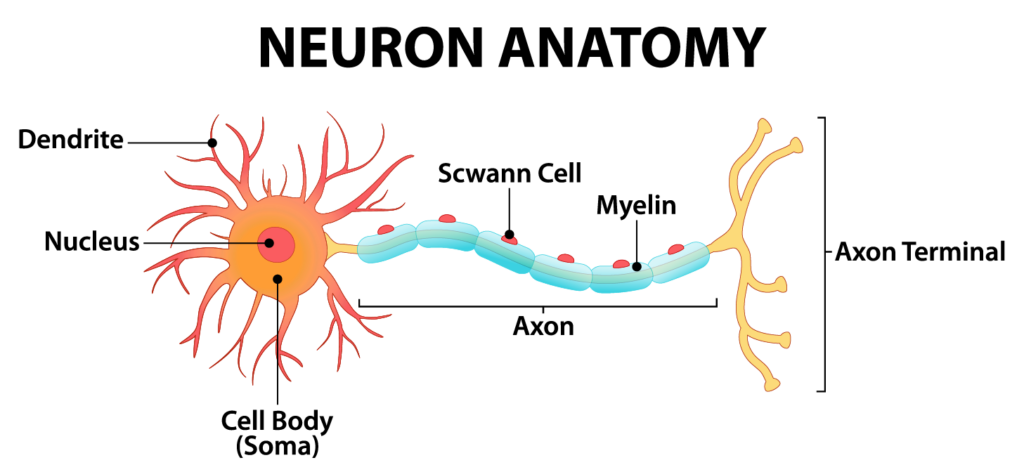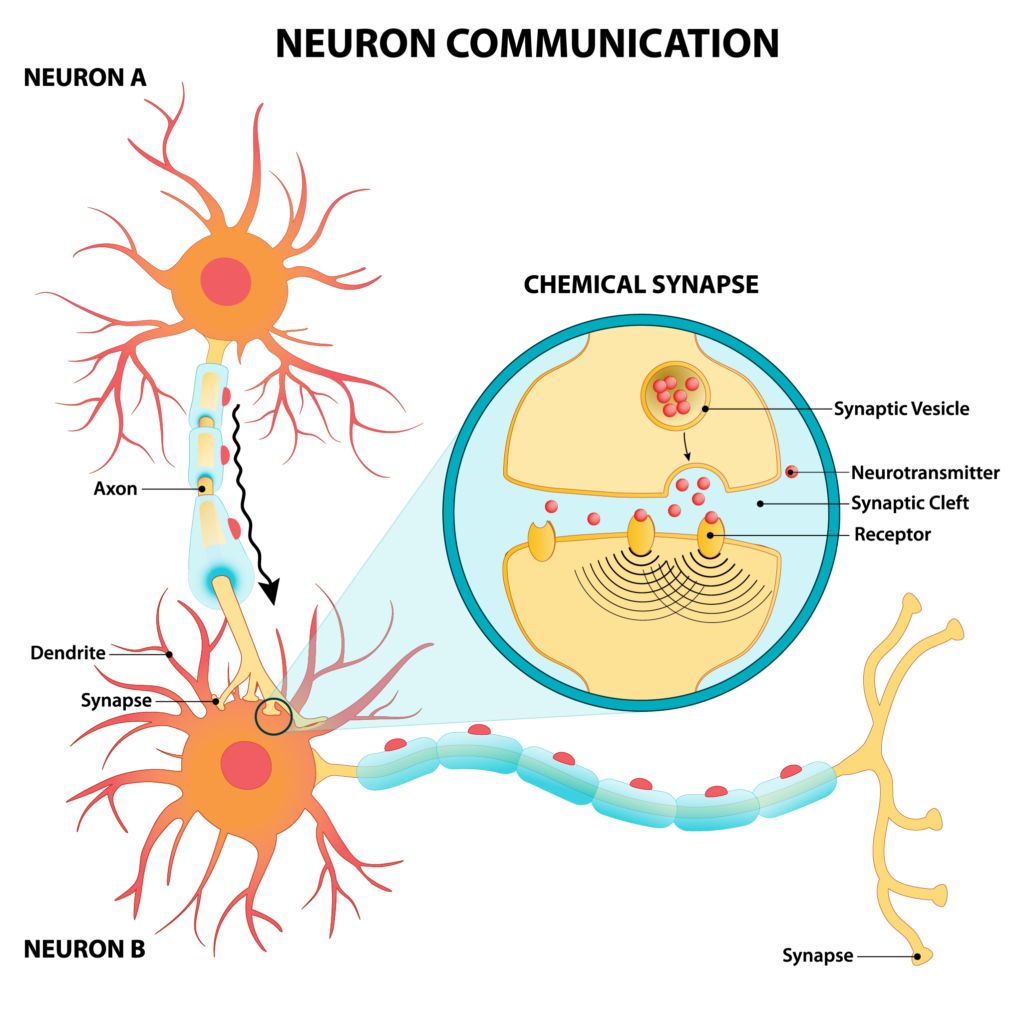What are neurons?
Neurons (or nerve cells) are the basic working units of the brain and nervous system. They are information messengers, using electrical impulses and chemical signals to transmit information between different regions of the brain and between the brain and the rest of the nervous system.[1] There are thousands of types of neurons, but scientists classify them into three broad types based on function:[2]
- Sensory neurons help you sense the world around you – they work with physical and chemical inputs from the external environment. Things like sound, touch, and light are physical inputs, and smell and taste are chemical inputs. These neurons send information from sensory receptors (in your skin, eyes, nose, etc.) toward the central nervous system.
- Motor neurons are crucial for voluntary and involuntary movements. They allow the brain and spinal cord to communicate with muscles, organs, and glands all over the body. They send information away from the central nervous system to the muscle, organ, or gland that needs to react.
- Interneurons are the most common type of neuron. They send information between sensory neurons and motor neurons, often forming complex circuits to help you react to external stimuli (like signaling to pull your hand away after touching a hot stove).
What do neurons look like?
Neurons are structurally and functionally different than other types of cells – they are uniquely designed for the purpose of communication between cells. A neuron has three main parts: a cell body (or soma), dendrites, and an axon.

The cell body (soma) is the base of the neuron. It contains genetic information, maintains the neuron’s structure, and provides energy to carry out the neuron’s work.[3]
The axon is a long, thin structure that carries information from its home neuron to another neuron via electrical impulse. Many axons are covered in a fatty substance called myelin, which helps the axons conduct an electrical signal.[4]
The dendrites are where a neuron receives information from other cells. They branch out from the cell body like antennae and receive and process signals from the axons of other neurons. Neurons can have multiple sets of dendrites, depending on the neuron’s function.[5]
How do neurons communicate?

The junction where two neurons meet is called a synapse and is where intercell communication takes place. Neurons communicate with one another through action potentials (changes in a neuron’s electric potential) and neurotransmitters.[6]
When an action potential is triggered in a neuron, it travels down the axon and causes neurotransmitters to be released into the synaptic cleft, the gap between Neuron A’s axon and a dendrite on Neuron B.[7] The neurotransmitters travel across the synaptic cleft and attach to receptors on Neuron B’s dendrite. Depending on the neurotransmitter released, particular positive or negative ions will travel through the dendrite’s membrane, creating an electrical signal in Neuron B. Essentially, synapses convert an electrical signal (the action potential) into a chemical signal (the neurotransmitters) and then back into an electrical signal once it meets the next neuron.[8]
Neurotransmitters
As a key player in neuron communication, neurotransmitters are an essential part of everyday functioning. Scientists have identified over 100 different types of neurotransmitters, each playing a different role in an individual’s brain chemistry. Abnormal levels of some neurotransmitters can contribute to mental health conditions.[9]
Serotonin is the key chemical that stabilizes mood and feelings of well-being. It also helps regulate appetite, digestion, and sleep. Many antidepressant medications are SSRIs, or selective serotonin reuptake inhibitors, and reduce feelings of depression and anxiety by increasing serotonin levels in the brain.[10]
Dopamine is important for memory, learning, behavior, and motivation. It is sometimes called the “reward” neurotransmitter because it creates positive feelings associated with accomplishment that motivate us to continue with a task. Dopamine is also associated with pleasure and is released during enjoyable activities.[11]
Norepinephrine, also called noradrenaline, helps the body respond to stress and increases as part of the fight or flight response. It also plays a role in signaling the body when to wake up each morning, increases attention on tasks, and assists in memory storage. Low norepinephrine levels are associated with depression, anxiety, PTSD, and substance use, while bursts of the chemical can lead to euphoria as well as panic attacks.[12] Some mental health medications are SNRIs (serotonin and norepinephrine reuptake inhibitors) and work on both neurotransmitters.
Mental health and brain communication
Scientists believe that abnormalities in how certain brain circuits function can lead to the development of a number of mental health conditions. Connections between neurons along specific brain pathways can contribute to challenges with how the brain processes information, sometimes resulting in abnormal mood, thinking, or behavior.[13] Brain communication isn’t only impacted by brain chemistry – the brain also reacts to signals from the gut, or “second brain.” The brain and gut communicate through chemicals like hormones and neurotransmitters, and those chemical messages can be affected by gut bacteria (called the “gut microbiome”). To learn more about the gut-brain connection and other non-medication ways of managing mental health challenges, check out the science behind mental health and recovery.
[1] Woodruff, A. (2019, August 13). What is a neuron? Queensland Brain Institute. https://qbi.uq.edu.au/brain/brain-anatomy/what-neuron
[2] Vandergriendt, C. (2018, July 20). What are neurons? Healthline. https://www.healthline.com/health/neurons
[3] Ibid.
[4] Woodruff, A. (2019, August 13). What is a neuron? Queensland Brain Institute. https://qbi.uq.edu.au/brain/brain-anatomy/what-neuron
[5] Vandergriendt, C. (2018, July 20). What are neurons? Healthline. https://www.healthline.com/health/neurons
[6] Queensland Brain Institute. (2017, November 9). Action potentials and synapses. https://qbi.uq.edu.au/brain-basics/brain/brain-physiology/action-potentials-and-synapses
[7] Woodruff, A. (2019, August 13). What is a neuron? Queensland Brain Institute. https://qbi.uq.edu.au/brain/brain-anatomy/what-neuron
[8] Queensland Brain Institute. (2017, November 9). Action potentials and synapses. https://qbi.uq.edu.au/brain-basics/brain/brain-physiology/action-potentials-and-synapses
[9] Cherry, K. (2020, June 22). Neurons and their role in the nervous system. Verywell Mind. https://www.verywellmind.com/what-is-a-neuron-2794890
[10] Berry, J. (2019, October 11). What are neurotransmitters? MedicalNewsToday. https://www.medicalnewstoday.com/articles/326649
[11] Ibid.
[12] Dimaraki, E. (2019, September). Norepinephrine. Hormone Health Network. https://www.hormone.org/your-health-and-hormones/glands-and-hormones-a-to-z/hormones/norepinephrine
[13] Ackerman, S. (1992). Discovering the Brain. National Academies Press. Retrieved from https://www.ncbi.nlm.nih.gov/books/NBK234144/
